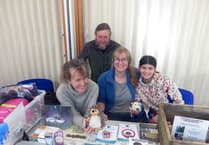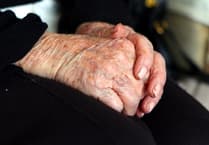AT their April meeting, members of Thorverton History Society welcomed Michael Parrott, who gave a talk entitled “Polish 307 Squadron - Lwow Eagle Owls”.
Michael has no Polish links but has researched the background of the Polish night fighter squadron based in Exeter for a period during the Second World War.
He is a friend of the Higher Cemetery at Heavitree and whilst exploring the history of one of the chapels he found a plaque in Polish. This plaque was to remember the life of a Polish navigator from this squadron who was shot down over the Dutch coast and has no known grave.
The navigator’s widow, Betty, went to Poland and saw a stone memorial to her husband so she carved a copy in wood and presented it to Exeter City Council. They placed it in the chapel as 19 of his comrades are buried here.
Germany invaded Poland in 1939 and Polish airmen were ordered to evacuate. Their route took them to Romania where they were issued with false passports and then they were shipped to France.
They joined the French air force but were not liked by the French who blamed them for the German invasion. When France capitulated they were offered the chance to go to Argentina or “last hope island” which was the UK.
All of them chose to come to the UK and they arrived in Liverpool. A total of 15,000 members of the Polish air force reached the UK during the war years.
Having arrived they were moved from Liverpool to Blackpool and 16 squadrons were formed. One of these was 307, the only night fighter squadron.
Their first plane was the Defiant but the only armament was a rear firing gun and the Luftwaffe soon took advantage of a plane with no forward firing guns.
At first the squadron was not allowed to fly by the RAF and had to practice formation work by riding bicycles around the air field. It was only when a Polish pilot demonstrated his ability to fly and managed to take off his flying suit whilst doing so did they convince the RAF they were competent flyers.
The squadron moved to Exeter in April 1941. Officers were allowed to stay in local hotels but other ranks were billeted in tents at the air field. During an enemy attack on the airfield one crew managed to get a plane off the runway and shot down a German bomber.
The navigator of this plane was Sgt Stanislaw Jarzembowski who died later in the war when the plane he was in made an emergency landing at Winkleigh air field.
The pilot and an air cadet were knocked out by the hard landing but Stanislaw managed to throw them both out of the plane before it exploded, killing him.
British pilots started hooting at the Polish air crews because they likened them to owls as they were only seen at night but the owl connection stayed and helped create their name along with the addition of the Polish city of Lwow. After the Defiant plane they were provided with Beaufighters.
These were supplied with on board radar which was in its infancy. The RAF required this to be kept totally secret and, to check the security, a senior RAF officer visited Exeter air field dressed as a German officer.
He entered a hanger and said his greetings in German but was immediately attacked by a mechanic with a wrench. A few days later the RAF wing commander wrote to the senior Polish officer praising the action of the mechanic.
Their new plane, the Beaufighter, was not a good plane to fly and if it lost one of its two engines it was very difficult to land. Of the 19 Polish airmen buried at Exeter, 17 were killed in accidents. They had responsibility to defend an area from Lands End to Portsmouth and up to Swansea.
In May 1942 up to 40 Luftwaffe bombers headed up the Exe on a bombing raid on Exeter. The squadron had four Beaufighters available to them and they managed to shoot down four enemy bombers, saving Exeter from the further damage they may have inflicted.
The Beaufighters were replaced with the Mosquito, a very fast two-engine plane made of wood but it still suffered from the same problem as the Beaufighter if it lost an engine.
In March 1943 the Squadron moved from Exeter to a base near Swansea and they became an offensive force rather than a defensive one, mostly covering the Bay of Biscay.
They were used as a distraction force when the dambusters raid was carried out, drawing the German planes away from the real target area.
When the war ended they were unable to return home to Poland so many stayed in the UK. Squadron Leader Jan Michalowski organised many events to raise money for the rebuilding of Exeter but tragically lost his life when a flight demonstration went wrong and he crashed into a parked Spitfire at the airfield.
More information can be found on the 307 website and “Facebook” and from November 14 to 16 there will be an exhibition at Exeter Guildhall.
Robert Turner




